Dr Peter Ridd compiled the statistics on coral reefs around the world, and even though China has installed a million megawatts of coal fired power in the last twenty years, there’s no evidence that corals are suffering significantly.
Statistics on corals barely existed before 1980, and didn’t get semi reasonable until 1998 or so. But with twenty years of data there is no evidence suggesting we need to send in the SWAT teams with floating shade sails, giant fans, breeding teams, or sunscreen for staghorn coral.
We do however need to send in the SWAT team to rescue our universities.
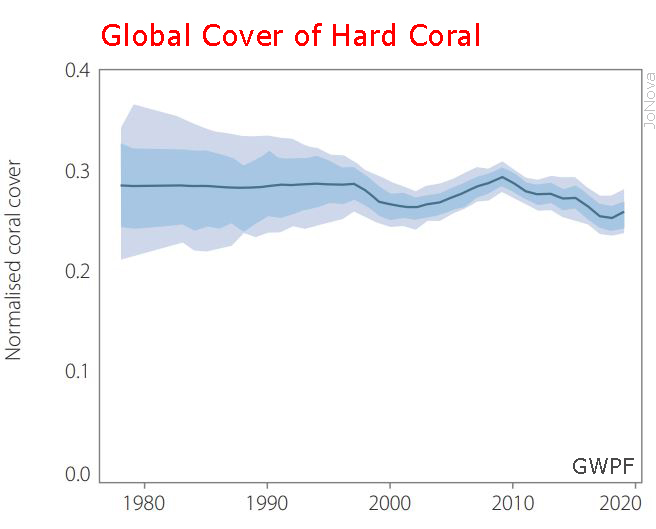
Hard Coral around the world is not suffering a mass die-off due to climate change, GWPF
Bleached is not killed
Academic shaman have implied (tacitly) that bleached coral is like dead coral, but instead bleaching is more like home redecoration and the corals recover surprisingly fast. But amongst all this noise of loss and recovery, and with such short term data it’s been hard to see the big picture.
The uncertainty bars on early coral studies expand like an emergency flare. But notice that there is no significant, distinctive response from corals despite CO2 being a well mixed gas spread all over the world. Where CO2 looks bad for some reefs one decade, it looks good the next. It’s almost like corals are being affected by something else entirely…

GWPF, Peter Ridd, 2023 (click to enlarge)
Peter Ridd takes a closer look at the four most important regions of corals, and the news for marine life is good.

Hard Coral Cover of the East Asia Region, GWPF
Why fear warming when corals love the hottest large water body on Earth
The area of most coral diversity, the ‘Coral Triangle’, in the seas around Indonesia, Papua New Guinea and the Philippines, is located at the centre of the Indo-Pacific Warm Pool – the hottest large water body on earth. This is not a coincidence. For every 1°C reduction in water temperature, there is a roughly 15% reduction in growth rate. Corals are also found in colder water, such as Scotland and Alaska, but their growth rate in these places is so slow that they are unable to form reefs.
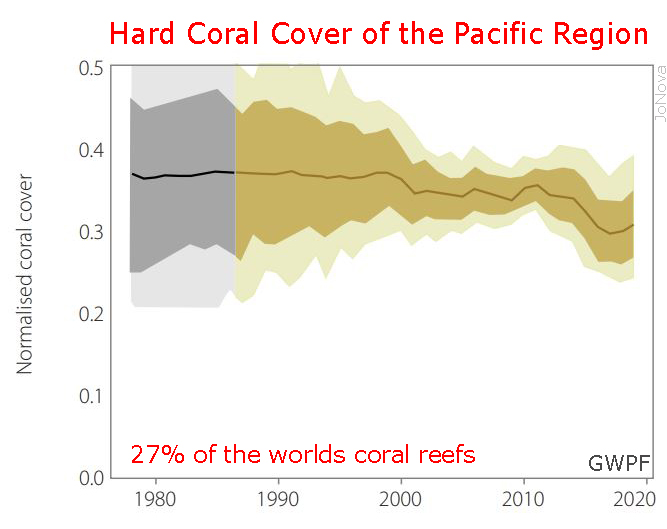
Hard Coral Cover of the Pacific Region, GWPF
Because most of a reef is underwater, determining longterm changes in condition is difficult; historical archives of aerial photographs cannot be used.11 This is in contrast to monitoring the decline of the world’s tropical rainforests, where clearing of rainforests has been documented for about a century. The reduction in rainforest extent in Africa, Asia, and South America can be easily inferred from old maps and modern aerial photographs.
Compared to rainforest loss, reefs are almost untouched
To put this in perspective — we know we’ve lost half of the Australian rainforest yet all 3,000 reefs off Queensland are still there:
For example, Google Earth images can be used to infer a 50% loss of Australian tropical rainforest, and almost total loss of lowland rainforest, since the European settlement, due to clearing for agriculture. Farms are now located where rainforest would once have been. However, for the GBR, all that can be said is that there has been no physical destruction of any reef on the scale of clearing for agriculture. All 3000 of GBR‘s reefs still exist, and all have coral on them.
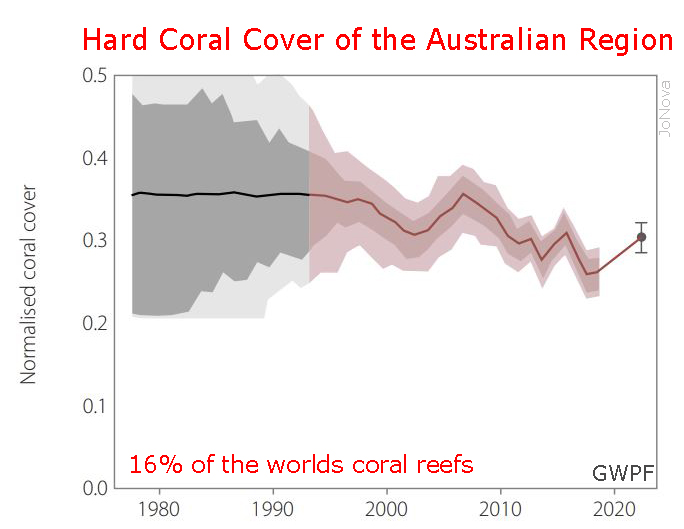
Hard Coral Cover of the Australian Region, GWPF
Lord help us, it’s hard to get good data
Data for Australian corals is probably the best in the world, but despite effectively surveying a strip of coral 1,000 kilometers long every year, the Great Barrier Reef is so large we are only sampling 0.003% of the total area.
In order to appreciate the magnitude and difficulty of the task of monitoring reef systems, it is useful to consider the GBR, which has, by far, the most comprehensive monitoring program in the world. Carried out by the Australian Institute of Marine Science (AIMS), the ‘Long Term Monitoring Program’ (LTMP) only started in the mid-1980s – sporadic data exists for earlier periods, but is too limited for determining long-term trends. The GBR is huge – larger than Germany and as long as California – and has 3000 individual reefs, each a few kilometres across. AIMS surveys roughly 100 of the reefs each year using Manta tows, which means they cover roughly 1000 km each year. Despite this huge distance, the area surveyed represents only roughly 0.003% of the total area of the marine national park. In addition, AIMS covers around 100 small set transects with benthic surveys.
The Caribbean reefs have survived three million years of climate change
The coral cover in the Caribbean is lower than other regions, but hasn’t changed much in the last twenty years. The region has been separated from other coral regions for three million years — so has evolved on its own path. It’s hard to say if the lower coral cover is due to human or other damage that may have started long ago, or is just because these reefs have a different mix of species.
In any case, it doesn’t correlate with CO2 either.

Hard Coral Cover of the Caribbean Region, GWPF
Fast coral recovery is written off as “just the quick growing species”
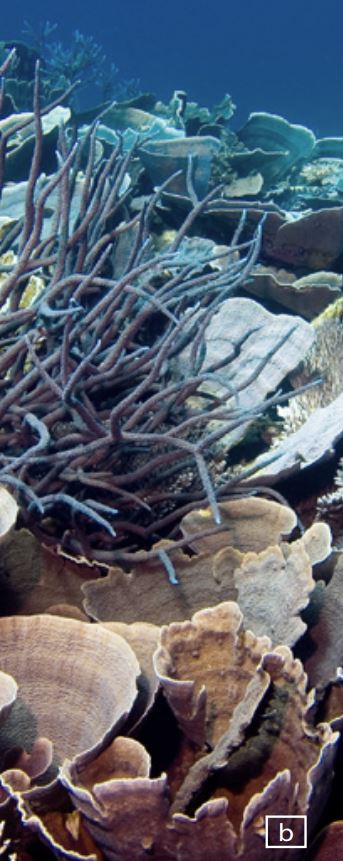
These are fast growing and delicate ‘plate’ and ‘staghorn’ corals that are
extremely susceptible to damage by storms and starfish plagues.
When corals recover fast the academics and media imply that the new growth is somehow not as good or strong as what was lost. But as Peter Ridd points out they can’t have it both ways. These fast growing species are the same ones that got hit in the bleaching episodes in the first place. Slow growing corals are tougher and harder to bleach. So the new fast growing corals are just replacing the injured fast growing corals.
Some corals like to live fast and die young
These corals use bleaching as a strategy to adapt to different conditions.
Some ‘high octane’ zooxanthellae will allow the coral to grow fast, but will make it more susceptible to bleaching from high temperatures. ‘Low octane’ zooxanthellae will make it grow slowly, but leave it less susceptible to bleaching.
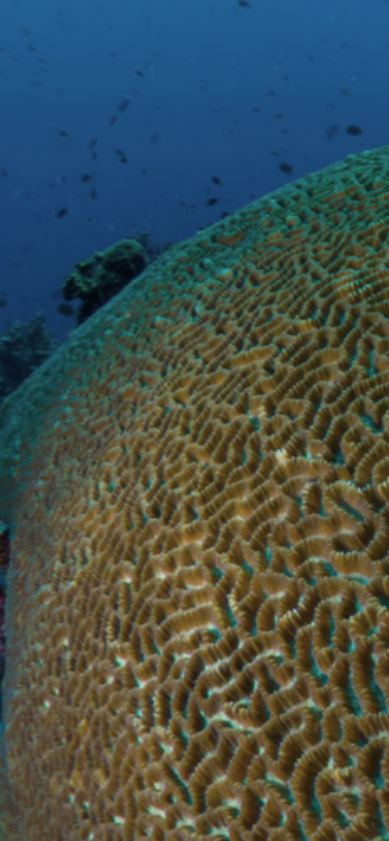
An example of a ‘massive’
coral. These are slow growing but can live for centuries. They are relatively unsusceptible to bleaching.
The life strategy of many corals, particularly the light and delicate ‘plate’ or ‘staghorn’ corals (Figure 1b), is to live fast and probably die young. They produce a lightweight calcium carbonate skeleton, which means that they will probably be obliterated by a tropical cyclone within 20 years. They are also highly prone to being eaten by crown-of-thorns starfish. As it happens, the return incidence for bleaching events and cyclones is often roughly the same and it is probably no coincidence that these physically delicate and easily damaged corals are the most susceptible to bleaching, and have a life expectancy of just a couple of decades. Taking on high octane zooxanthellae and growing quickly, while risking death by bleaching, is all part of their life strategy. At the opposite extreme are the massive corals that can live for centuries and become a solid block of calcium carbonate, metres across, and weighing tons. These grow more slowly, and will generally pass through a cyclone/hurricane relatively unharmed and are less affected by starfish plagues. They have a long-term strategy, and quick death by bleaching is not part of it.
Bleached is not the same as dead coral
These reefs recovered so fast they could not have been killed in the first place. A coral that has been killed will need ten years to recover, but a bleached one is just redecorating with newer better zooxanthellae.
While they [fast growing corals] can indeed regrow extremely rapidly (within a year) from a small section that is left alive (the so-called ‘phoenix effect’), if they are killed, recruitment of larvae and regrowth takes 5–10 years. They cannot regenerate within a few months. The rapid recovery of the reef cover therefore shows that they were bleached, but not killed. In other words, the past few years’ data has proven that very little coral was killed by the bleaching events – even the fast-growing coral that is most susceptible. Coral reefs can double or even quadruple their coral in a decade. The loss of a few percent from bleaching is a minor disturbance.
Coral comes pre-adapted to climate change
Few other organisms have this type of adaptability to changing temperatures. Whereas many organisms take generations to alter their genetic make-up, corals can adapt to changing temperatures in a few weeks, simply by switching zooxanthellae during bleaching. Corals thus have a remarkable, almost unique, ability to deal with changing climates. Are they the ‘canary in the coal mine’, or one of the toughest organisms on earth, or somewhere in between?
Academic tricks to make an 8% death rate seem like 93%
The legendary 2016 bleaching was essentially word-game hyperbole:
… it was widely reported that the 2016 bleaching event of the GBR affected 93% of reefs, with the implication that there was a 93% coral loss. However, if a reef had only a very small amount of bleaching, it was classified as one of the 93% of reefs that bleached…
The best estimate for total coral loss on the GBR during the 2016 bleaching event is that, at most, about 8% died. Almost all of this was in very shallow water, less than 5 meters deep.
Frade et al. (2018) showed that coral loss in water between 5 and 40 m depth was about 3%. Figure 4 demonstrates without doubt that the coral loss was small compared to the regeneration capacity of the reefs. Although there is no doubt that a significant amount of coral was killed by bleaching in 2016, it was far less than can be destroyed by a major cyclone, and far less than what was effectively reported by the media. This confirms previous work by De’ath et al. (2012) who found that cyclones and starfish plagues are responsible for 90% of coral mortality, and bleaching just 10%.
The bottom line: The Reefs may or may not be fine, but science is in trouble
Although it is extremely encouraging news, the latest statistics about coral reefs around the world, and especially recent ones from the GBR, do not prove that the world’s reefs are all going to be fine. However, they prove without any shadow of a doubt that the coral reef science community, with a few exceptions, is lacking in scientific integrity. They have cried wolf too often.
REFERENCE
Peter Ridd, (2023) Coral in a Warming World, Causes for Optimism, GWPF, February